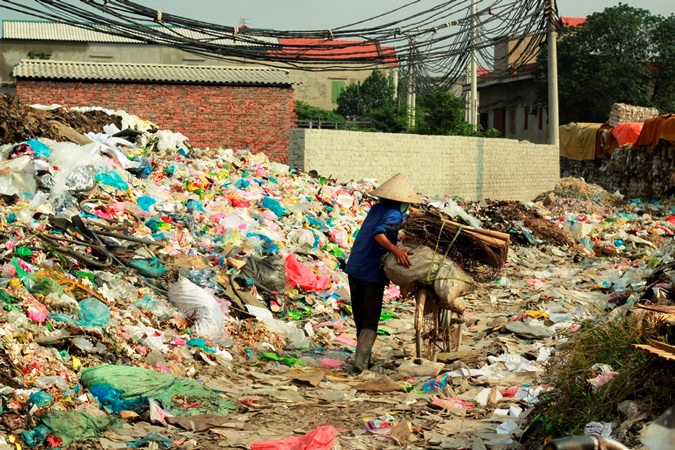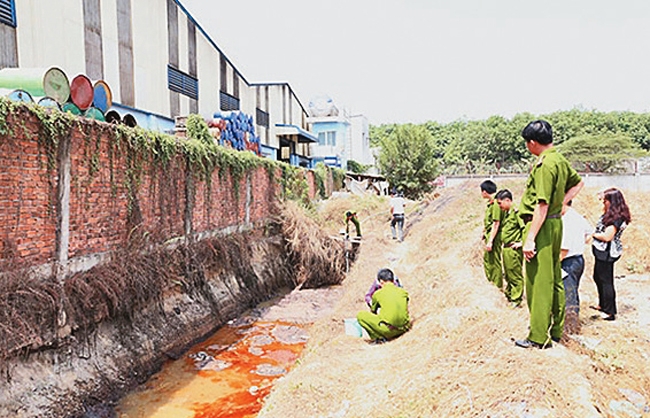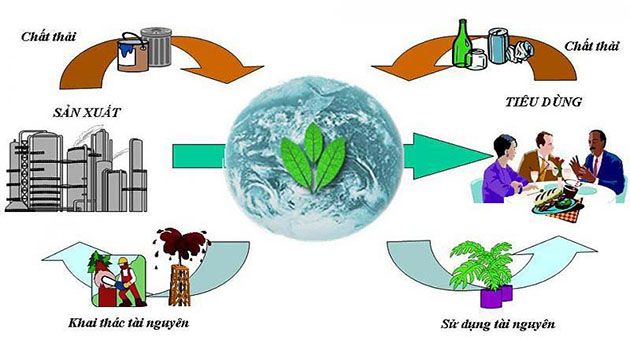It is necessary to continue to institutionalize the Law on Environmental Protection 2014 of Vietnam
Environmental protection is one of the top priorities of the Party and the State. Resolution No. 24-NQ/TW of June 03, 2013 of the 7th Conference of the 11th Central Committee of the Party clearly stated that: Actively responding to climate change, strengthening natural resources management and environmental protection are issues of special importance, with great impact, interrelated, and affecting each other, together determining the sustainable development of the country; is the basis and premise for planning economic and social development policies of Vietnam.

The Law on Environmental Protection 2014 was approved by the 13th National Assembly of Vietnam at its 7th session, effective from January 01, 2015.
After one year of implementation, sub-laws have been issued with many contents adjusted to be suitable with the reality of state management on environmental protection. Based on the inheritance and development of the successes of the previous stage, the Law on Environmental Protection 2014 of Vietnam is considered an important step forward to continue improving the effectiveness of environmental protection work in the new stage. In order for the legal provisions to go into effect, at the same time clearly define the responsibilities of the sectors and levels in the process of implementing the Law, raising awareness of the levels, sectors, agencies, organizations, businesses and people in compliance with the law on environmental protection is one of the key tasks of state management on environmental protection work today.
Obstacles and shortcomings need to be removed
According to the assessment of environmental experts from the Center for People and Nature, the Law on Environmental Protection 2014 and the sub-laws have concretized some contents related to environmental rights. Chapter II of the Law on Environmental Protection 2014 specifically regulates consultation in the formulation of environmental protection planning and environmental impact assessment (EIA). Chapter XV also specifies the responsibilities of the Vietnam Fatherland Front, political-social organizations, social-professional organizations, and communities in environmental protection.
However, the content of environmental consultation and monitoring has many points that have not been clearly guided in these 02 Decrees, which are Decree No. 19/2015/ND-CP of Vietnam’s Government detailing the implementation of a number of articles of the Law on Environmental Protection, and Decree No. 18/2015/ND-CP of Vietnam’s Government on environmental protection assessment, strategic environmental assessment, environmental impact assessment and environmental protection plans. Specifically, Article 21 of the Law on Environmental Protection in 2014 stipulates that the objects to be consulted are agencies, organizations, and communities directly affected by the project. Identifying specific objects directly affected is not simple because the project has many phases and impacts at each phase are different, so it includes different groups. For example, for a hydropower project being implemented, the objects directly affected by the project are the households in the reservoir, so they are informed and consulted. But when the project goes into operation, the group that is greatly affected by their livelihoods and water resources is the communities living in the downstream area, which are ignored in the consultation process.
In addition, Decree No. 18/2015/ND-CP has overcome the limitations of the previous "community representative" mechanism, with people being consulted directly through community meetings chaired by the investor and the commune People's Committee. However, in addition to the progress, there are still some limitations, such as the lack of criteria for determining "objective opinions and reasonable recommendations" that the investor must accept. Additionally, there is no clear mechanism for the investor's accountability in the event that the investor does not accept the opinions and recommendations in writing or at the community meeting. The form of community consultation meetings has not been clearly specified in terms of the implementation process, including the provision of information and materials before consultation, the minimum number of meetings to share information and answer questions related to the project, and the assessment of the results of the community meeting in the document responding to the consultation of the commune People's Committee to the investor.
In addition, environmental impact assessment (EIA) on biodiversity is currently being neglected or avoided in EIA reports due to the following reasons: The stakeholders involved do not fully understand the meaning of biodiversity, as well as the risks to ecosystems, populations, and species in nature; There are insufficient regulations and specific guidelines on EIA in biodiversity, including appropriate assessment objects and criteria, unified standards and methods for measuring and counting the degree of impact on biodiversity, and a list of projects with a high risk of having a significant impact on biodiversity that are required to be assessed; etc. Based on these shortcomings, it is clear that, due to the specific nature of EIA on biodiversity, the Ministry of Natural Resources and Environment needs to issue additional specific technical guidelines. This institutionalization is also a prerequisite for gradually improving the capacity and awareness of stakeholders about biodiversity.
Another shortcoming in the Law on Environmental Protection 2014 is the issue of environmental dispute resolution. According to Dr. Nguyen Van Phuong, Hanoi Law University: The practice of resolving environmental disputes in recent times shows that the majority of cases in this field have been successfully resolved mainly through mediation, with the participation of government agencies. This could be a testament to the superiority of mediation activities over court proceedings in recent times. Therefore, it is necessary to stipulate that mediation of environmental disputes, especially disputes over compensation for damages, is a mandatory procedure before filing a lawsuit in court. In cases where compensation for damages cannot be claimed, it is necessary to develop regulations to support the injured entity under the principle of community responsibility.
Currently, the Law on Environmental Protection 2014 still lacks mechanisms to implement the rights of political-social organizations, social-professional organizations, and communities, and mechanisms to compel civil servants and government agencies to fulfill their obligations. The law does not yet have a provision on the right of people to request environmental information. The law only stipulates the assessment of environmental damage but does not stipulate the assessment of damage to life, health, and property of the injured party. The law also does not have regulations on the method of payment of compensation for those who are injured when the total amount of damage is determined and the party causing the damage agrees to compensate for this amount. Therefore, competent agencies also need to build regulations on the assessment of damage to life, health, and property of the injured party, principles, procedures for determining damage to each injured entity within the total damage, or mechanisms to implement the "allocation" of compensation money for those who are injured on the principles of transparency, democracy, fairness, and openness. In addition, it is necessary to apply the environmental liability insurance mechanism to share the responsibility of the person causing the damage and ensure the timeliness and quickly have enough financial capacity to compensate. Although this mechanism has been stipulated in the Law on Environmental Protection 2014, to date, there are still no regulations to implement it.
Suggestions and recommendations
To improve the effectiveness and efficiency of state management of environmental protection, in the coming time, it is necessary to accelerate the pace of building and issuing guiding documents for the implementation of the Law on Environmental Protection 2014; regularly review, revise and supplement regulations that are still lacking or not in line with reality. In this regard, it is necessary to continue to institutionalize and enhance the effectiveness of consultation in the process of implementing the EIA report, such as building technical guidelines for the EIA report of specific projects, clearly identifying the types of impacts of the project according to the investment, construction, and operation stages. In the guidance on the process of implementing EIA and consultation, it is necessary to clearly specify the responsibilities and penalties for the investor and the competent authority for receiving and responding to information. Publicize the contact information of individuals and organizations responsible for responding to information and specify the response time. Build a specific monitoring mechanism, any findings during the monitoring process must be reported to the state management agency and this agency must take appropriate measures. Improve and update the national environmental database to facilitate the search and access to information.
Strengthening dialogue between businesses and localities in many forms to listen to feedback on the regulations issued, from which to summarize and have a plan to amend and supplement for appropriate. In the long run, it is necessary to study the formation of the legal framework on environmental protection in line with reality and the requirements of state management in order to limit changes in a certain period of time, causing confusion for localities and businesses.
Strengthening the work of propaganda, dissemination, and training on environmental protection laws for state management agencies in localities and businesses. Through this, production and business establishments will clearly understand their specific responsibilities and how to comply with the law, as a basis for implementation in practice; at the same time, strengthen the work of inspection, inspection, and supervision of compliance with the law of production, business, and service establishments. This is an activity that creates a change immediately after inspection and inspection through the tools of punishment, suspension of operation, public disclosure of violations, etc.
Source: dangcongsan.vn
- Key word:
- Law on Environmental Protection 2014
- Number of deputy directors of departments in Vietnam in accordance with Decree 45/2025/ND-CP
- Cases ineligible for pardon in Vietnam in 2025
- Decree 50/2025 amending Decree 151/2017 on the management of public assets in Vietnam
- Circular 07/2025 amending Circular 02/2022 on the Law on Environmental Protection in Vietnam
- Adjustment to the organizational structure of the Ministry of Health of Vietnam: Certain agencies are no longer listed in the organizational structure
- Vietnam aims to welcome 22-23 million international tourists in Vietnam in 2025
-

- Vietnam: Enterprises that discharge waste into ...
- 14:50, 27/09/2020
-

- Illegally extracting natural resources is strictly ...
- 14:28, 03/02/2017
-

- Basic contents on environmental impact assessment ...
- 14:53, 01/01/2017
-

- Vietnam: Environmental protection is the responsibilities ...
- 14:40, 27/12/2016
-

- Vietnam: Perfecting environmental laws to ensure ...
- 17:36, 10/10/2016
-

- Notable new policies of Vietnam effective as of ...
- 16:26, 11/04/2025
-
.Medium.png)
- Notable documents of Vietnam in the previous week ...
- 16:21, 11/04/2025
-
.Medium.png)
- Notable documents of Vietnam in the previous week ...
- 16:11, 02/04/2025
-
.Medium.png)
- Notable new policies of Vietnam to be effective ...
- 16:04, 02/04/2025
-
.Medium.png)
- Notable new policies of Vietnam effective from ...
- 14:51, 21/03/2025
 Article table of contents
Article table of contents
